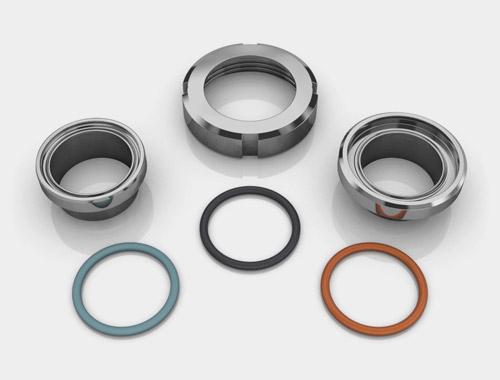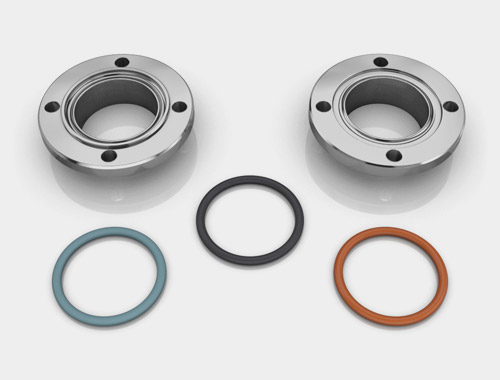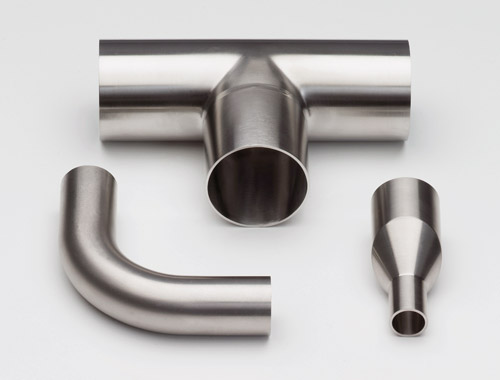Sterile technique
Screwed pipe connections DIN 11864-1 + DIN 11853-1

The aseptic and the hygienic screwed pipe connections are compatible and differ only in the axial length. They are used with process facilities for liquid media with high purity requirements. Preferential fields of application are bio-engineering, cosmetics, chemical, pharmaceutical, food, and beverage industry.
Sterile pipe screw connections are available either as aseptic pipe screw connections according to DIN 11864-1 or as hygiene pipe screw connections according to DIN 11853-1. They are used mainly with liquid media in process plants with high hygiene demands. Processing in bio and sterile technology as well as in the pharmaceutical industry and cosmetic industry and in the food industry and chemical industry demands aseptic processes or the hygienic conditioning of the mainly liquid media.
Coaxial forced-centring of collared ferrule and threaded ferrule takes place in the assembly of the pipe screw connections DIN 11864-1 and DIN 11853-1. The slotted nut is pushed over the collared ferrule and screwed onto the threaded ferrule until the end faces are touching. In this way, the O-ring held independently in the collared ferrule is deformed such that an almost dead space-free flange connection is established.
The pipe screw connections can be delivered with material surface Ra inside <0.8µm and Ra outside <1.6 µm, corresponding to H3. Also surfaces H4 and H5. The O-rings are delivered in materials EPDM, VMQ, FKM, EPDM and FKM USP Class VI as well as PTFE-FKM-seamless coated and FDA-conform.
The standard DIN 11864-1 is part of the three-part standard series DIN 11864 and applies for aseptic pipe screw connections. The standard defines O-rings and pipe connection ferrules in lengths with normal version for butt welding to pipes in accordance with DIN 11866. The standard is intended for application to the chemical and pharmaceutical industry. Previous application also to the short versions of the flange lengths has since been replaced by definitions in the additional standard DIN 11853-1.
The standard DIN 11853-1 was compiled based on the recommendations of the EHEDG "European Hygienic Equipment Design Group" and applies for hygiene pipe screw connections with O-ring, short version for butt welding to pipes with dimensions according to DIN 11866 and DIN 11850, series 2. The hygiene pipe screw connections are designed for the following permissible pressures: - pipe outer diameters of 12.7 mm to 41.0 mm: 4.0 MPa (40 bar); - pipe outer diameters of 42.4 mm to 104.0 mm: 2.5 MPa (25 bar). These pressures in MPa (bar) can be applied when using suitable gasket materials from -10 °C to +140 °C.
Flange pipe connections DIN 11864-2 + DIN 11853-2

The aseptic and the hygienic flange pipe connections are compatible and differ only in the axial length. They are used with process facilities for liquid media with high purity requirements. Preferential fields of application are bio-engineering, cosmetics, chemical, pharmaceutical, food, and beverage industry.
Aseptic and hygiene flange connections are used in process plants with high hygiene demands. Mainly in biotechnology, the cosmetic, pharmaceutical, chemical, food and beverage industries.
In the assembly of this pipe connection system, screws are pushed through the holes at the edges of the flanges First the O-ring is inserted in the grooved flange where it is held independently. The collared flange is placed against it so that the two flanges interlock. The flanges are tightened evenly with screws until the end faces are touching smoothly. The O-ring is deformed to produce a smooth and almost dead space-free passage.
The flange connection is also suitable for hygienic applications for processes according to CIP, DIP, SIP and WIP as well fulfilling the regulations, e.g. according to EHEDG and GMP.
Clamp pipe connections DIN 11864-3 + DIN 11853-3

The aseptic and the hygienic clamp pipe connections are compatible and differ only in the axial length. They are used with process facilities for liquid media with high purity requirements. Preferential fields of application are bio-engineering, cosmetics, pharmaceutical, chemical, food, and beverage industry.
Aseptic and hygiene clamp connections are used in process plants with high hygiene demands. Mainly in biotechnology, the cosmetic, pharmaceutical, chemical, food and beverage industries.
In the assembly of this pipe connection system, stable clamping rings made of die-cast half shells are placed around the flanges. A certificate based on the TUEV parts tests regarding pressure load capacity is also available for the "FL-Stabil" clamping rings.
Either wing nuts or hexagonal nuts are available as a clamping ring closure. The O-ring inserted previously in the grooved clamping ferrule is held independently in the groove. The collared clamping ferrule is placed against it so that the two flanges interlock. The clamp connection is therefore force-centred and a clamp is closed around the flanges. The end faces are then touching smoothly and the O-ring is deformed so that a smooth, dead space-free passage is produced.
Aseptic fittings for orbital welding DIN 11865

The aseptic fittings for orbital welding are used especially with process facilities for liquid media with high aseptic requirements. Preferential fields of application are bio-engineering, cosmetic, chemical, pharmaceutical, food, beverage, and semiconductor industry.
The welded fittings according to DIN 11865 are aseptic mouldings and connections for welding to aseptic flanges as well as hygiene flanges. The reducing pieces, bends and T-pieces are made of stainless steel and are designed for orbital welding. The reducing pieces are turned from forgings or steel bars, whilst the bends and T-pieces are made from tubes in accordance with DIN 11866. The tube ends are calibrated, angled, flat, sharp-edged and burr-free.
The surface roughness is offered as a standard in H2. Hygiene classes H3, H4 and H5 are also available. Therefore the following surface qualities of the pipe inside surface are possible:
Hygiene classes
H2
H3
H4
H5
Inner surface
Ra < 0,8 µm
Ra < 0,8 µm
Ra < 0,4 µm
Ra < 0,25 µm
Inner welding seam
Ra < 1,6 µm
Ra < 0,8 µm
Ra < 0,4 µm
Ra < 0,25 µm